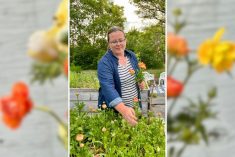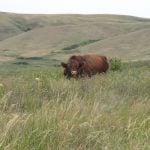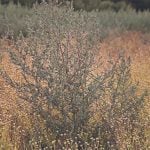A generation ago, Sarah Wray might have gone looking for a farm organization to join. Maybe she would even have started a new club so beginning farmers such as she and her husband Logan could learn from others about getting off to a good start. Or she might have opened up a new branch of Junior Farmers.
Instead, the young Alberta farmer turned to the Net. Instead of looking for a meeting to attend, she and a handful of friends helped build a website for beginning farmers, got government funding to pay for it, and are getting credited with doing a world more good than they ever could at a club meeting.
Read Also

Will investments in defence benefit Canadian agriculture?
A bump in Canada’s NATO spending commitments could lead to infrastructure investments that would benefit rural areas
It s a sign of how Generation Y is going to do things differently.
Not only is this the first generation of farmers to have grown up with keypads welded to their fingertips, it s also a generation with new insights into the power of groups.
Collaboration will create greatness, Wray tells me with firm conviction.
Yet this generation is also easy to misunderstand. In fact, unless you make a special effort to listen in, it s a generation that you re almost certain to get wrong. Which is a pity, because it s already clear that this is a generation that intends to make its mark.
Communicating with Generation Y is a whole new playing field for most in agriculture, says Wray, a part-time farmer from Bashaw, Alta., and one of the founders of FarmOn, a website for young farmers.
Every generation is distinguished by its experiences and expectations, as well as by the way it works and communicates. Farmers born from 1922 to 1945 are often called Traditionalists or Builders, and were influenced by the Great Depression and the Second World War. Then came the post-war wave of Baby Boomers, followed by Generation X, or the MTV Generation as it sometimes called, which was born from about 1965 to 1980.
Now a new group of farmers is entering the profession. Generation Y was born between the early 1980s and the new milennium, and this latest generation of farmers has its own unique way of communicating and working, and it has its own way of setting priorities too.
Plus, unlike any other generation in recent memory, they re launching their farming careers in a swell of grain market optimism and amidst a new wave of farmer-direct selling and computer technology.
Our generation is part of the information age, says Wray. And using social media is second nature to us.
Started in 2007 by five friends who showed cattle together, www.farmon.com was initially created with financial backing from AVAC Ltd. as a way for new farmers to share experiences and learn about the business of farming. We felt there was a real disconnect between what was actually happening and us, says Wray.
The friends also thought their generation needed a way to sort though the information overload while still having a chance to show and discuss ideas that can actually help. This is a multi-tasking generation, after all. A Gen Y farmer is often simultaneously establishing a new farm business and working at an off-farm job, pursuing post-secondary education, and even raising a young family.
Not unlike many starting farmers, Wray and Logan both work full time off the farm. They also have three young children, and on top of that they direct market meat and eggs and are building a show-quality breeding herd of beef cattle on their quarter section.
I look for my information at midnight, when it s too dark to work on the farm and the kids are asleep, says Wray.
FarmOn s recently updated platform, funded by Rural Alberta Development Fund and a Rural Diversification Initiative grant, combines social networking with e-learning. The Farm Masters portion delivers extension content in short videos, downloadable PDF documents and audio podcasts.
Farmers can also ask questions and interact with expert guides, all while forming relationships with their peers that essentially become their own online support system.
The goal isn t to recreate the information, says Wray. It s to engage farmers and experts of all ages to discuss the information. It s also a way to link new farmers with actionable resources, mentors and the general public.
We all strive to make our businesses better but sometimes we can t do it alone, says Wray. It takes the power of many.
Texting, instant messaging and email are tools for unprecedented connectivity, but they aren t alone. There s also sharing videos through websites like YouTube, plus other broadly used social networking sites including Facebook, MySpace and Twitter.
In an agriculture where the distances between farms and between farmers and consumers are getting larger every day, this is a generation that has refused to let distance become an obstacle.
Farming has changed already, purely because communication has changed, says Wray. By engaging the general public and by injecting their opinions into farm businesses strategies, Wray says farmers will continue to improve. In fact, she says it s unavoidable at this point.
Reflecting the social network all-inclusive concept, FarmOn is open to all experiences and promotes the conversation around that, both positive and negative. It s like a big coffee shop, says Wray. We hope it provokes thoughts, tests credibility.
Yet this is also an impatient generation. Online communities can test and filter innovations quickly and widely. Innovation in our industry has been underfunded, says Wray. We need new thoughts and new ideas.
Next spring, the FarmOn Foundation wants to open their site to the broader agricultural community. For example, company crop specialists could not only reach their own farmers through the FarmOn platform, they could also capture an expanded audience within the FarmOn community.
If history repeats itself, Gen Y will continue evolving. In just a few short years email and chat rooms have become antiquated for many young people. Mobile apps are taking over.
Mentorship and guidance are huge for my generation, says Wray. This is a way to capture and share this wealth of knowledge before it disappears. CG What Generation Is Your Farm?
Ag marketing theory crashes with reality on Meredith Fuller s desk. She s vice-president of public relations at Quarry, an agricultural advertising firm in Waterloo, Ont., and she also farms part-time with her husband, Paul Knafelc.
They grow 12 acres of fruit in the heart of the Niagara Region, including strawberries, pearches and sweet cherries. They also work with Knafelc s family, which farms next door, while another farmer manages and harvests about four acres of pears on their property. The couple sells at the farm gate and at a local farmers market.
It all means Fuller brings perspectives not only as career executive and farm business partner, but also as both marketer and buyer, listener and talker.
Painting all young farmers with the same communications brush can be a mistake, Fuller says.
Yes, some topics and issues do affect young farmers more than their older counterparts, or perhaps it s different perspectives on those topics. However, she says generational divisions shouldn t be used too rigorously, especially when you re talking to farmers.
The label young can become shorthand for attributes such as innovativeness, tech savviness, willingness to take risks, and willingness to try new products or production practices, Fuller says. That s a mistake, she says, Many older farmers are quite tech savvy, innovative and first-adopters of new technology, products, and techniques.
Instead she says the critical differences often lie more in stage of the farm and the size of the operation, not in the age of the farmer. Most young farmers are in a family farm that they will likely take over, Fuller says, so communication also needs to consider the life-stage of the farm as opposed to the age of the farmer.
For example, a new farmer just getting into the business or into a new type of production requires and appreciates much different information than a third-generation farmer on a long-standing family operation, even though they could both be the same age.
In Fuller s experience, farm size is often used more than farmer age in determining not only what is communicated, but how it is communicated. For example, since growers with large operations spend more, they typically get more attention from the companies, with reps driving up the laneway to talk machinery, seed and pesticides.
However, more companies are coming to grips with the need for multiple venues, says Fuller. For example, chemical companies produce both hard copy and online versions of product guides, and they produce mobile apps to assess disease pressure while still hiring agronomists to walk fields.
Ag companies are also getting more sophisticated at customizing their grower communication, so growers get messages targetted directly at them, Fuller says. As an industry we perhaps aren t as far along that curve as others are, but it is improving.
QUICK CONNECT
When Rodney Voldeng from Naicam, Sask. answers his cellphone, he says he d like to be part of our discussion, but could I email him so he can respond when he s not on the combine? Like most of the younger generation, Voldeng is open to sharing his opinion, but prefers communicating by computer.
Voldeng and his brother Doug grow 3,600 acres of grains and oilseeds. They also used to have a farrow-to-finish operation but depopulated three years ago with the decline in pork prices. Voldeng has a degree from the University of Saskatchewan and is chair of the Saskatchewan Young Ag-Entrepreneurs, where his wife, Gwenda, is general manager.
For Voldeng, regular mail service is too slow, so information that comes in the mailbox tends to be the last to get looked at when time is tight. Littering the mailbox with all kind of gimmicks is not a good way to get young farmers attention, he says in his email written in the evening.
His smartphone, particularly via texting and Internet sourcing, is his communication conduit of choice. Young farmers utilize more social media than ever before and communicate greatly by use of their cell-phones and texting, Voldeng says.
Voldeng receives daily market updates through text messaging on his cellphone from a number of end users. It s extremely handy in helping me make marketing decisions, especially during the very busy times of the farming year, he says.
He has noticed for most young, commercial scale farmers like himself, most input purchases are dictated by price, then performance and availability. That may not be all that different from his parents generation.
Also, most younger farmers shop for equipment at auction sales with price dictating many purchases.
However, when negotiating with dealers, service is high on Voldeng s priority list. Again, that can be true of older farmers too.
What may often be different, though, is his reliance on mobile technology to help manage both sides of the balance sheet. Young farmers today are willing to shop around for price and service, Voldeng says, and they will deliver their product many miles away, if it s best for their operation.
———
THE SURVEY SAYS&
Roughly 30 per cent of the farmers in Agri Studies Inc. s recent survey of commercial-size farms report they are using social media. That may not be a surprise. What s surprising, though is that there didn t seem to be any difference across age groups.
Is it enough to debunk the idea that the entire younger generation is addicted to Facebook, while older farmers don t even know what it is?
Social media is simply another way to communicate, says Justin Funk, managing partner of Guelph-based Agri Studies and president of the Canadian Agri Marketing Association (CAMA).
In the Agri Studies grower survey, starting farmers made up only three per cent of total respondents. Even so, it s important for retailers to go after their business, Funk says.
They re at a stage when they really value the extra service, Funk says. Get them while they re starting, especially for smaller local retailers. It pays to spend time for the future even though it takes extra work.
Besides, he says, smaller producers also mean more profit. They need help and information, and are willing to pay for it. According to marketing theory, if there s less competition, like in niche markets, you can charge more.
Still, the ag inputs sector also needs to get ready for the fact that Gen Y is going to change the game. In particular, this is a group that s hard to tie down. The industry has built itself on loyalty, Funk says. We re not going to be able to hang our hat on it anymore.
Yet in other ways, Gen Y farmers are the same as any others. Regardless of age or size of operation, the Agri Studies survey showed that the single most important factor in influencing farmers purchase decisions is their own experience with the product.
That means Gen Y farmers need more service and more information, but it also means an opportunity for suppliers who are willing to go the extra mile and give Gen Y farmers one-on-one help.
As innovation, performance and price become more important, suppliers will have to create new ways to sell, says Funk.
Pioneer dairy specialist for all of Canada, Robert Larmer, recently bought a farm west of Peterborough and lives and breathes mobile, real-time communication. Although some of his Gen Y customers have complete reign over all decisions, many are on multi-generational farms and don t always make the final decision. Still their opinion matters.
Larmer has a Twitter account to communicate with his younger customers, passing on things like yield information on a daily basis. Larmer s not sure buying decisions are based on his tweets, but he says it s a way to build a relationship with younger farmers. I m one of them so we understand each other, he says
Says Larmer: The younger-generation farmers may not have enough influence yet to say yes, but they definitely can say no.
———
Farm stage often means more than farmer age, says Quarry s Fuller














